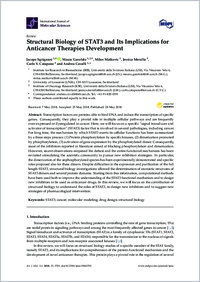Structural biology of STAT3 and its implications for anticancer therapies development
- Sgrignani, Jacopo Institute for Research in Biomedicine (IRB), Faculty of Biomedical Sciences, Università della Svizzera italiana, Switzerland
- Garofalo, Maura Institute for Research in Biomedicine (IRB), Faculty of Biomedical Sciences, Università della Svizzera italiana, Switzerland - University of Lausanne (UNIL), CH-1015 Lausanne, Switzerland
- Matkovic, Milos Institute for Research in Biomedicine (IRB), Faculty of Biomedical Sciences, Università della Svizzera italiana, Switzerland
- Merulla, Jessica Institute of Oncology Research (IOR), Faculty of Biomedical Sciences, Università della Svizzera italiana, Switzerland
- Catapano, Carlo V. Institute of Oncology Research (IOR), Faculty of Biomedical Sciences, Università della Svizzera italiana, Switzerland
- Cavalli, Andrea Institute for Research in Biomedicine (IRB), Faculty of Biomedical Sciences, Università della Svizzera italiana, Switzerland
-
28.05.2018
Published in:
- International journal of molecular sciences. - 2018, vol. 19, no. 6, p. 1591
English
Transcription factors are proteins able to bind DNA and induce the transcription of specific genes. Consequently, they play a pivotal role in multiple cellular pathways and are frequently over-expressed or dysregulated in cancer. Here, we will focus on a specific “signal transducer and activator of transcription” (STAT3) factor that is involved in several pathologies, including cancer. For long time, the mechanism by which STAT3 exerts its cellular functions has been summarized by a three steps process: (1) Protein phosphorylation by specific kinases, (2) dimerization promoted by phosphorylation, (3) activation of gene expression by the phosphorylated dimer. Consequently, most of the inhibitors reported in literature aimed at blocking phosphorylation and dimerization. However, recent observations reopened the debate and the entire functional mechanism has been revisited stimulating the scientific community to pursue new inhibition strategies. In particular, the dimerization of the unphosphorylated species has been experimentally demonstrated and specific roles proposed also for these dimers. Despite difficulties in the expression and purification of the full length STAT3, structural biology investigations allowed the determination of atomistic structures of STAT3 dimers and several protein domains. Starting from this information, computational methods have been used both to improve the understanding of the STAT3 functional mechanism and to design new inhibitors to be used as anticancer drugs. In this review, we will focus on the contribution of structural biology to understand the roles of STAT3, to design new inhibitors and to suggest new strategies of pharmacological intervention.
- Language
-
- English
- Classification
- Medicine
- License
- Open access status
- gold
- Identifiers
-
- RERO DOC 326704
- DOI 10.3390/ijms19061591
- ARK ark:/12658/srd1318914
- Persistent URL
- https://n2t.net/ark:/12658/srd1318914
Statistics
Document views: 190
File downloads:
- Texte intégral: 258
